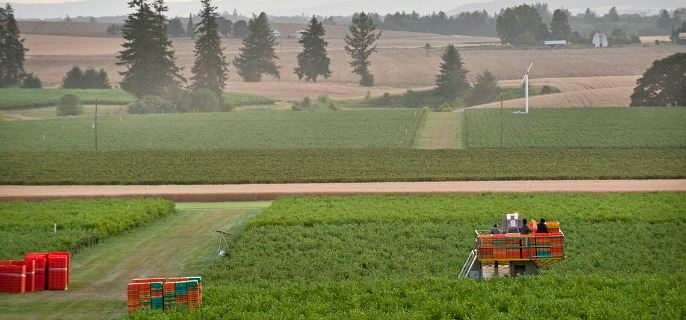
PHOTO COURTESY OF ODA
Oregon agriculture’s large impact on the state’s economy is reaffirmed by an updated analysis and report released by Oregon State University. The OSU study, commissioned by the Oregon Department of Agriculture, quantifies the contributions of producers, processors, and others in a variety of economic snapshots ranging from sales to employment.
“We’ve talked consistently about the importance of agriculture to Oregon’s economy and the numbers found in OSU’s report validate what has been said,” says ODA Director Katy Coba. “What we think is happening in agriculture is indeed taking place.”
The report, Oregon Agriculture, Food and Fiber: An Economic Analysis, builds on previous OSU studies done in 2008 and 2011 to assess agriculture’s economic footprint and ripple effect on the state. It details the entire cycle of agriculture– from the farm to the consumer– and connects the flow of dollars throughout the system, capturing production, processing, distribution, wholesale, retail, and food service.
Using a variety of currently available data, the report generally shows that the industry continues its steady growth. Specifically, it finds agriculture is directly and indirectly linked to about $50 billion in sales of goods and services, which is more than 13 percent of the statewide total of sales involving all industry sectors. The report also finds that Oregon agriculture directly or indirectly supports more than 326,000 full or part-time jobs, making up almost 14 percent of total jobs in the state. Overall, Oregon agriculture is responsible for $22.9 billion or 10.6 percent of the net state product.
“Whichever measurement you want to use, those are all big numbers that show agriculture’s huge contribution to Oregon’s economy,” says Coba.
Spread throughout the report are compelling stories captured by statistics.
While the number of Oregon farms, ranches, and total farm acreage has decreased in recent years, the output of Oregon farms has increased 39 percent to $5.7 billion dollars between 2010 and 2014.
“Our producers aren’t really getting paid that much more for their crops, so they’ve become much more productive, and those numbers reflect that,” says Coba.
Measuring efficiency is another byproduct of the OSU study, according to its primary author.
“One of the most important points in this report is the tremendous work farmers and ranchers have done by improving the use or efficiency of their inputs like water, land, and chemicals,” says OSU Extension Economist Bruce Sorte. “Oregon was ranked 46th out of the 50 states in terms of agricultural total factor productivity in 1960 and it advanced to 15th with the highest level of improvement among all the states. Farmers and ranchers are still improving each year working with researchers in universities, government, and businesses. This is very good news for consumers, producers, and ecosystems.”
A section of the report focuses on processing– adding value to what is agriculturally produced. In 2013, more than $12 billion was added to the farmgate sales of Oregon-grown food and fiber by processors and food services. Frozen food manufacturing tops the list of processing sectors in terms of sales followed by breweries, fluid milk manufacturing, canned fruits and vegetables, wineries, and cheese manufacturing.
Sorte underscores the importance of value-added agriculture while saying more can be done.
“Adding value– increasing the value of wheat at ten cents a pound to flour at fifty cents a pound, providing water to a dryland farm so it can grow an irrigated crop, or Oregon fruit or beef served in a restaurant– is such an important and difficult process. If we encourage these value-added efforts for Oregon’s exports and as substitutes for imports of food to Oregon, we could at least double the already sizable value-added contribution of the agriculture, food and fiber industry of $23 billion.”
The report looks at distribution and marketing. A section on farm direct sales quantifies the growing interest by consumers who want to buy local food. The report also captures the jump in organic agriculture sales, now up to 4 percent of total ag sales in Oregon. A look at ag exports indicates how “new dollars” brought into Oregon from international customers and consumers from across the US help the state’s economy grow.
“Agricultural, food, and fiber production and processing account for 10.9 percent of all Oregon exports, or a total of $15.2 billion in sales,” says Mallory Rahe, Extension Community Economist and report co-author.
The report specifically notes that the more “finished” the good or service is before it is exported or used to substitute for an import, the greater the value added to the state’s economy.
The state’s agricultural leaders are encouraged by the report’s findings.
“Agriculture is the handshake between the urban and rural communities in Oregon,” says Dan Arp, Dean of OSU’s College of Agricultural Sciences. “Our agricultural producers and processors sustainably provide the high quality foods and beverages that all Oregonians take pride in and enjoy daily. This report demonstrates that agriculture also has a profound economic impact on the state both in terms of sales and jobs. Agriculture is indeed key to Oregon’s economic success.”
ODA Director Coba concurs.
“Agriculture is a very important part of Oregon,” she says. “In terms of population, the number of farmers and ranchers in our state is small. Yet, when you look at the contribution they make to both our economy and our environment, things we pride ourselves on, agriculture has a tremendous impact on the state.”
As for the report itself, don’t expect it to simply gather dust while sitting on a shelf in someone’s office. The study can be used to convince policy makers that what is generally good for agriculture is good for the Oregon economy. Simply put, agriculture is more than just farming. For the 1-in-7 Oregonians who have a job connected to agriculture, the report should make them feel good about their contribution to the state’s economy.










